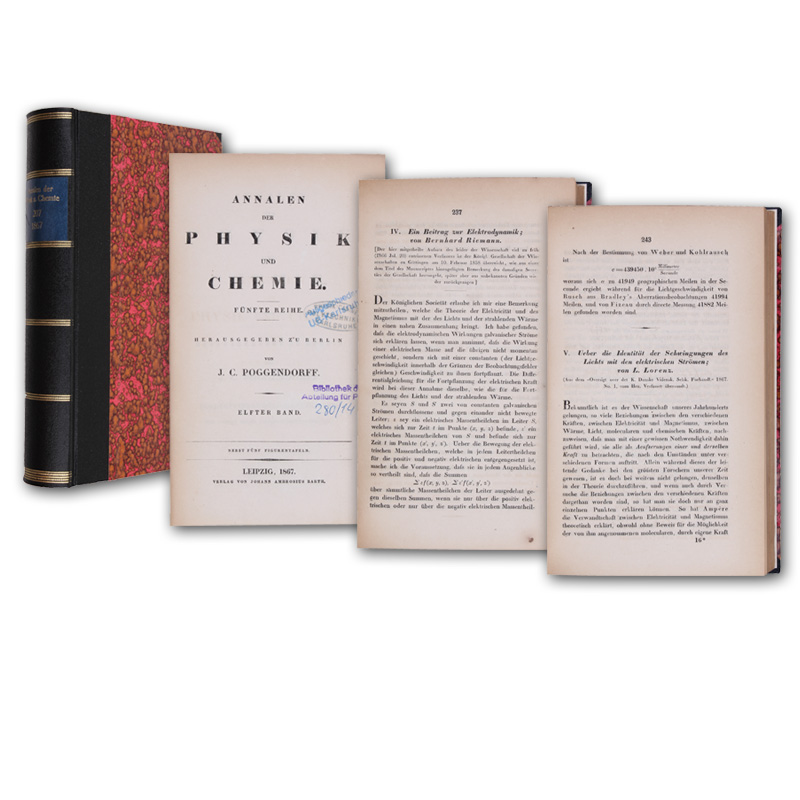97324-03
Ein Beitrag zur Elektrodynamik. SS. 237-243. - Und: L(udwig) Lorenz. Ueber die Identität der Schwingungen des Lichts mit den elektrischen Strömen. SS. 243-263. In: Annalen der Physik und Chemie. Band 131.
Leipzig, Barth, 1867. - (21,5 x 13 cm). (2) X, 660 S. Mit 5 gefalteten lithographierten Tafeln und 2 gefalteten Tabellen. Moderner Halbleinwandband im Stil der Zeit.
Zu I: Erste Ausgabe dieser posthum erschienenen Arbeit; von Riemann bereits 1858 der Kgl. Gesellschaft der Wissenschaften zu Göttingen überreicht, aber wieder zurückgezogen. - Er bestimmt hier das Potential zweier elektrischer Teilchen mit Hilfe der Laplace-Poisson Gleichung und kommt zu dem Ergebniss, dass die Theorie der Elektrizität und des Magnetismus eng mit der des Lichtes zusammenhängt und dass die Ausbreitungsgeschwindigkeit elektromagnetischer Wellen gleich der Lichtgeschwindigkeit ist. - Poggendorff III, 1122. - Zu II: Erste deutsche Ausgabe. - "Most impressive of all Lorenz' achievements in optics is his electromagnetic theory of light, developed in a relatively unknown paper of 1867, two years after Maxwell's famous paper on the same subject. At that time Lorenz did not know Maxwell's theory, and his own approach was quite different. Lorenz' electromagnetic theory of light can be described briefly as an interpretation of the light vector as the current density vector in a medium obeying Ohm's law. This paper contains the fundamental equations for the vector potential and the scalar potential For - for the first time - the corresponding retarded potentials expressed in terms of the current density vector and the electrical charge density. The concept of retarded potentials had already been introduced in an earlier paper by Lorenz in connection with research on the theory of elasticity. He found that the differential equation for the current density vector was the same as his fundamental wave equation for the light vector, completed with a term which explains the absorption of light in conducting media, and that his theory led to the correct value for the velocity of light" (DSB 8, 501). - Stempel auf Titel. Papierbedingt leicht gebräunt, sonst gut erhalten.
Ein Beitrag zur Elektrodynamik. SS. 237-243. - Und: L(udwig) Lorenz. Ueber die Identität der Schwingungen des Lichts mit den elektrischen Strömen. SS. 243-263. In: Annalen der Physik und Chemie. Band 131.
Leipzig, Barth, 1867. - (21,5 x 13 cm). (2) X, 660 S. Mit 5 gefalteten lithographierten Tafeln und 2 gefalteten Tabellen. Moderner Halbleinwandband im Stil der Zeit.
Zu I: Erste Ausgabe dieser posthum erschienenen Arbeit; von Riemann bereits 1858 der Kgl. Gesellschaft der Wissenschaften zu Göttingen überreicht, aber wieder zurückgezogen. - Er bestimmt hier das Potential zweier elektrischer Teilchen mit Hilfe der Laplace-Poisson Gleichung und kommt zu dem Ergebniss, dass die Theorie der Elektrizität und des Magnetismus eng mit der des Lichtes zusammenhängt und dass die Ausbreitungsgeschwindigkeit elektromagnetischer Wellen gleich der Lichtgeschwindigkeit ist. - Poggendorff III, 1122. - Zu II: Erste deutsche Ausgabe. - "Most impressive of all Lorenz' achievements in optics is his electromagnetic theory of light, developed in a relatively unknown paper of 1867, two years after Maxwell's famous paper on the same subject. At that time Lorenz did not know Maxwell's theory, and his own approach was quite different. Lorenz' electromagnetic theory of light can be described briefly as an interpretation of the light vector as the current density vector in a medium obeying Ohm's law. This paper contains the fundamental equations for the vector potential and the scalar potential For - for the first time - the corresponding retarded potentials expressed in terms of the current density vector and the electrical charge density. The concept of retarded potentials had already been introduced in an earlier paper by Lorenz in connection with research on the theory of elasticity. He found that the differential equation for the current density vector was the same as his fundamental wave equation for the light vector, completed with a term which explains the absorption of light in conducting media, and that his theory led to the correct value for the velocity of light" (DSB 8, 501). - Stempel auf Titel. Papierbedingt leicht gebräunt, sonst gut erhalten.
420 €

